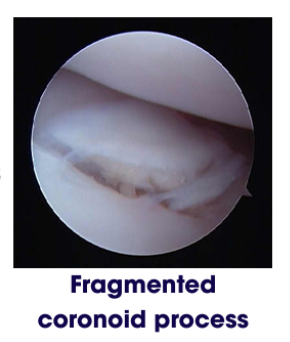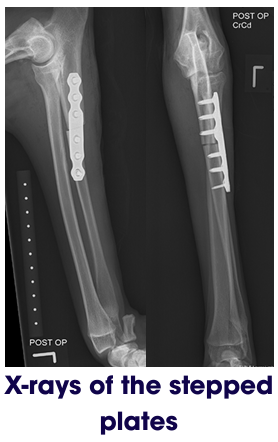About Elbow Dysplasia
Elbow dysplasia is a complex disease which results from a group of genetic conditions which cause parts of the elbow joint to develop abnormally, resulting in abnormal articulation of the “hinge” elbow joint between the humerus (upper arm bone) and the radius and ulna (lower arm bones).
Over time, the cartilage becomes damaged, and osteoarthritis develops.
Clinical Signs
Elbow dysplasia commonly affects large breed dogs, such as Labradors, German Shepherds, Bernese Mountain Dogs, Rottweilers and Golden Retrievers.
Clinical signs include:
- Forelimb lameness and stiffness after rising or strenuous exercise
- Reduced range of motion
- Pain on manipulation of the elbow joint may be found on orthopaedic examination, on one or both elbows
Investigation
X-rays of the elbows are used to demonstrate the degree to which the elbow formation is abnormal, some of the types of abnormalities present and the presence and severity of secondary osteoarthritis. In some dogs the x-rays may be normal.
A computed tomography (CT) scan may be suggested to further assess joint congruency (how well the joint “fits” together) and to identify small bone fragments.
Arthroscopy of the joint (keyhole surgery) may be recommended to evaluate the joint cartilage, which cannot be seen on x-ray or CT.
Surgical treatment of cartilage abnormalities can be performed as part of this procedure if required.
The severity of the signs of elbow dysplasia on diagnostic imaging and arthroscopy does not always correlate to the severity of clinical signs.


Conservative Treatment
Non-surgical treatment of elbow dysplasia cannot address the underlying developmental abnormalities of the affected joints, but focusses on managing the associated osteoarthritis.
Surgical Treatment
Arthroscopy
Arthroscopy is a “keyhole surgery” procedure that involves placing a camera into the affected joint in order to view cartilage lesions and potentially remove or treat damaged areas of cartilage.
The removal of damaged cartilage and bone fragments during arthroscopic treatment of the affected joints appears to variably improve patient comfort.
However, further development of osteoarthritis is unfortunately inevitable, resulting in progressive lameness.
Following arthroscopy, your pet’s lameness may initially be a little worse on the affected leg, but should improve fairly quickly.
Your pet will need to have two weeks of strict rest to allow the joint capsule to heal again before starting a gradual exercise programme.
Complications following arthroscopy include seroma formation (accumulation of f luid under the skin) and infection (less than 0.1% of cases).
Osteotomy Procedures
Dynamic proximal ulnar osteotomy (DUPO) is a procedure that may be considered in some dogs where the elbow joint does fit together properly. This ‘imperfect jigsaw’ may mean that the medial (inside) part of the joint has excessive load placed through it when walking, eventually leading to inflammation and osteoarthritis. By cutting the ulnar at a specific location we aim to unload the inside of the elbow joint and improve how the elbow joint fits together.
Total Elbow Replacement
Some dogs with severe osteoarthritis may not be a candidate for a DUPO or PAUL. A total elbow replacement is a salvage (“last resort”) procedure for dogs with long term elbow pain who have not responded to conservative treatment, such as pain relief and exercise modification.
The aim of the procedure is to allow dogs with severely compromised mobility and elbow pain to return to exercise. A recent multi-centre study showed the major complication rate of this procedure is very high. At the current time we are not offering total elbow replacements at Langford Vets. A new generation of improved implants are being developed so we hope to be able to offer this as an option again in the future.

